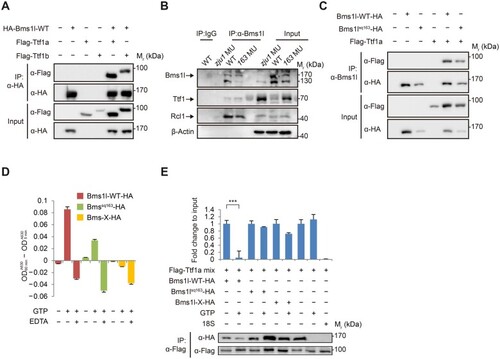Figure 6
- ID
- ZDB-FIG-220203-54
- Publication
- Zhu et al., 2021 - Nucleolar GTPase Bms1 displaces Ttf1 from RFB-sites to balance progression of rDNA transcription and replication
- Other Figures
- All Figure Page
- Back to All Figure Page
|
Bms1l interacts with Ttf1 and displaces Ttf1 from DNA-binding site with its GTPase activity. (A) Co-IP analysis showing that the overexpressed Bms1l (Bms1l-WT-HA) interacts with both Ttf1a and Ttf1b (Flag-tagged). Total protein was extracted from 293 T cells at 48 h after transfection with corresponding plasmids as shown and was subjected to Co-IP using an HA-tag antibody. (B) Co-IP analysis showing the successful pulldown of endogenous Ttf1 and Rcl1 by endogenous Bms1l or Bms1l163. β-Actin: loading control. (C) Co-IP analysis showing that the overexpressed Ttf1a (Flag-tagged) interacts with both Bms1l and Bms1l163 (HA-tagged). Total protein was extracted from 293 T cells at 48 h after transfection with corresponding plasmids as shown and was subjected to Co-IP using an anti-Bms1l antibody. (D) GTPase activity assay using purified proteins showing that Bms1l-X-HA is enzymatically inactive, while Bms1lsq163-HA exhibits ∼43% of Bms1l-WT-HA activity. Free phosphate concentration in each reaction was obtained by A630 color absorbance at 5 and 60 min, respectively. The subtracted value between 60 and 5 min is presented as the relative GTPase activity. (E) ChIP‒qPCR analysis for the effect of Bms1l on dissociation of the Ttf1a‒DNA complex. Purified Ttf1a was mixed with the peak-3 DNA and 10 µM GTP (Flag-Ttf1a mix). The mixture was then incubated with purified Bms1l-WT, Bms1l-163, or Bmsl1-X with or without 50 µM GTP for 60 min. Only Bms1l-WT-HA obviously dissociates the Ttf1a‒DNA complex. Lower panels: the Co-IP products (Ttf1a, Bms1l, or derivatives) were examined by western blotting with respective antibodies. ***P < 0.001. |

